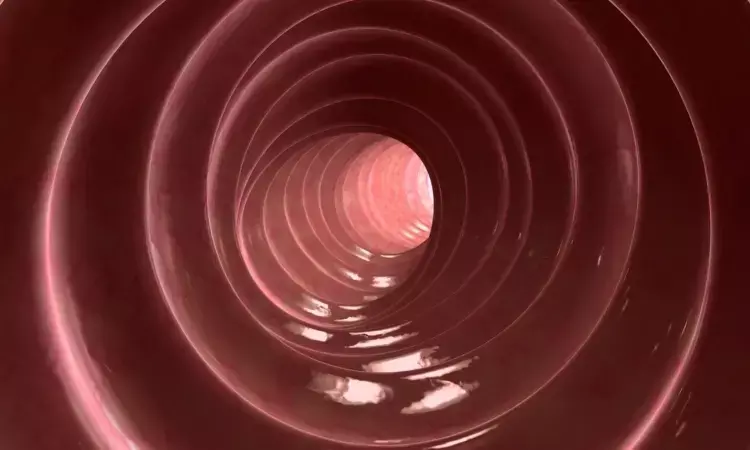- Home
- Medical news & Guidelines
- Anesthesiology
- Cardiology and CTVS
- Critical Care
- Dentistry
- Dermatology
- Diabetes and Endocrinology
- ENT
- Gastroenterology
- Medicine
- Nephrology
- Neurology
- Obstretics-Gynaecology
- Oncology
- Ophthalmology
- Orthopaedics
- Pediatrics-Neonatology
- Psychiatry
- Pulmonology
- Radiology
- Surgery
- Urology
- Laboratory Medicine
- Diet
- Nursing
- Paramedical
- Physiotherapy
- Health news
- Fact Check
- Bone Health Fact Check
- Brain Health Fact Check
- Cancer Related Fact Check
- Child Care Fact Check
- Dental and oral health fact check
- Diabetes and metabolic health fact check
- Diet and Nutrition Fact Check
- Eye and ENT Care Fact Check
- Fitness fact check
- Gut health fact check
- Heart health fact check
- Kidney health fact check
- Medical education fact check
- Men's health fact check
- Respiratory fact check
- Skin and hair care fact check
- Vaccine and Immunization fact check
- Women's health fact check
- AYUSH
- State News
- Andaman and Nicobar Islands
- Andhra Pradesh
- Arunachal Pradesh
- Assam
- Bihar
- Chandigarh
- Chattisgarh
- Dadra and Nagar Haveli
- Daman and Diu
- Delhi
- Goa
- Gujarat
- Haryana
- Himachal Pradesh
- Jammu & Kashmir
- Jharkhand
- Karnataka
- Kerala
- Ladakh
- Lakshadweep
- Madhya Pradesh
- Maharashtra
- Manipur
- Meghalaya
- Mizoram
- Nagaland
- Odisha
- Puducherry
- Punjab
- Rajasthan
- Sikkim
- Tamil Nadu
- Telangana
- Tripura
- Uttar Pradesh
- Uttrakhand
- West Bengal
- Medical Education
- Industry
Computer-aided detection tied to higher detection rates of colorectal neoplasia: Lancet

Italy: Gastroenterologists can benefit from computer-aided detection (CADe) approaches based on artificial intelligence algorithms in identifying colorectal neoplasia.
According to a new research, detection rates of colorectal neoplasia are greater with computer-aided detection (CADe) than with other techniques such as chromoendoscopy or instruments that improve mucosal visibility. This implies that CADe strategies should be more widely included in the community endoscopy services.
This study was conducted by Marco Spadaccini and the team with the idea of exploring the key role and utility of CADe and its comparison with existing tools in the same field. The findings of this study were published on 1st October 2021 in The Lancet Gastroenterology & Hepatology journal.
Researchers conducted a thorough search of the PubMed/Medline, Embase, and Scopus databases from inception to November 30, 2020, for randomized controlled trials investigating the efficacy of the following endoscopic techniques in detecting colorectal neoplasia: CADe, high definition (HD) white-light endoscopy, chromoendoscopy, or add-on devices (ie, systems that increase mucosal visualization, such as full-spectrum endoscopy [FUSE] or G-EYE balloon endoscopy). Adenoma detection rates, sessile serrated lesion detection rates, the fraction of big adenomas identified per colonoscopy, and withdrawal times were also gathered. The researchers used a frequentist framework and random-effects network meta-analysis to compare artificial intelligence to chromoendoscopy, enhanced mucosal visualization technologies, and HD white-light endoscopy (the control group).
The primary analysis comprised 50 randomized controlled studies with a total of 34 445 individuals. In all 50 investigations, HD white-light endoscopy was used as the control method. When compared to the control approach, the adenoma detection rate with CADe was 74% higher, 44% higher with chromoendoscopy, and 41% higher with enhanced mucosal visibility systems. Cross-comparisons of CADe with other imaging techniques revealed a substantial increase in the adenoma detection rate with CADe against enhanced mucosal visibility systems, as well as with CADe compared chromoendoscopy. As focused on large adenomas (10 mm), there was a substantial increase in detection only with CADe when compared to HD white-light endoscopy; CADe was regarded as the superior method for detection of large adenomas. Although no significant improvement in sessile serrated lesion detection rate was seen, CADe appeared to be the best method for detection of sessile serrated lesions. There was no statistically significant difference in withdrawal time between CADe and the other methods.
"CADe appears to have an advantage over other advanced endoscopy imaging techniques, such as chromoendoscopy or mucosal visualization tools, for increasing the detection of colorectal neoplasia," the authors wrote. "This supports wider incorporation of CADe technologies into community endoscopy services."
Reference:
Spadaccini M, Iannone A, Maselli R, et al. Computer-aided detection versus advanced imaging for detection of colorectal neoplasia: A systematic review and network meta-analysis. Lancet Gastroenterol Hepatol. Published online August 4, 2021.
doi:10.1016/S2468-1253(21)00215-6
Medical Dialogues consists of a team of passionate medical/scientific writers, led by doctors and healthcare researchers. Our team efforts to bring you updated and timely news about the important happenings of the medical and healthcare sector. Our editorial team can be reached at editorial@medicaldialogues.in.
Dr Kamal Kant Kohli-MBBS, DTCD- a chest specialist with more than 30 years of practice and a flair for writing clinical articles, Dr Kamal Kant Kohli joined Medical Dialogues as a Chief Editor of Medical News. Besides writing articles, as an editor, he proofreads and verifies all the medical content published on Medical Dialogues including those coming from journals, studies,medical conferences,guidelines etc. Email: drkohli@medicaldialogues.in. Contact no. 011-43720751


